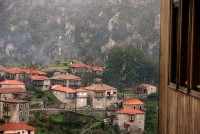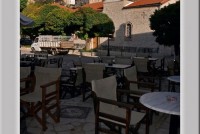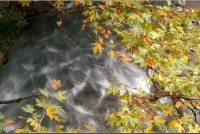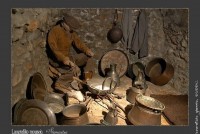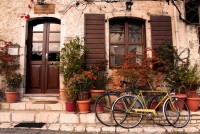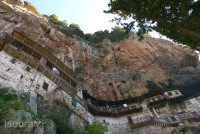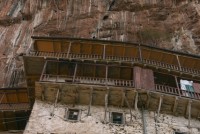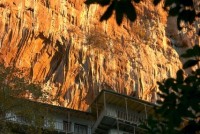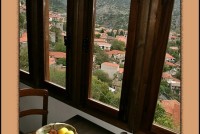[tabby title=”History”]
Stemnitsa (view photos), a beautiful town in Arcadia is built on the slopes of Mt. Menalon. It disappears from history in the mid 15th century until the 16th century, when we have the first written accounts of it. From the 18th century on, with the increase in its population, Stemnitsa became an important market town, a «chora» as it was called, and at the same time saw a remarkable cultural, artistic and economic development.
Along with its neighbouring towns in the province of Cortyna, Stemnitsa played an important role in the struggle for Greek independence. Characteristic of the regard in which Stemnitsa was held, is the address made to its people by the Gortyna-born Theodoros Deliyiannis, the then prime minister: «off all the Greeks the Peloponnesians are the most intelligent; of the Peloponnesians, the Arcadians; of the Arcadians, the Gortinians and of the Gortinians, the Stemnitsians».
Stemnitsa’s prosperity continued throughout the 19th century.
However, its decline started as early as the first decades of the 20th century, due to large-scale emigration and migration to urban centres. The old «chora» Stemnitsa, with its 3.000 inhabitants is sparsely populate today, but has kept alive its rich history.
The original Greek name of Stemnitsa is Ypsus. Το discover the beginning of its history, one must look far back through the ages to that ancient Greek mythology whose roots are to be found in prehistoric times. So, according to mythology, King Lycaon, whom Zeus in a rage had transformed into a wolf, had fifty sons and one daughter. Each of his sons founded a town in the area, naming it after himself and Ypsus was founded by the son of that name.
Its history follows the great moments of Greece without, in ancient times, playing a leading role in events.
The first Byzantine monuments in Ypsus date back to around the 6th century A.D. Consequently, it is considered certain that from that time on the area was inhabited by Christian farmers and craftsmen. These craftsmen toured the Southern Peloponnese practising their craft, resulting in the ultimate migration of many inhabitants of Ypsus to more fertile areas.
The renaming of Ypsus to Stemnitsa occurred in A.D. 746, a year of plague in the Peloponnese. The devastation of the region’s population and the intense demographic problem that followed, led the emperor in Constantinople, Constantine V, to allow the peaceful resettlement of Slavs from the North in the Peloponnese.
The new settlers took up animal husbandry and agriculture and, naturally, gave the places they lived in names descriptive of their topography. So, the area around Ypsus became Stemnitsa, which means a wooded place.
The «kastro» (or fortress), as it is still called tοday, bears witness to the passing of the Franks and was the conqueror’s stronghold. The Greeks and the Hellenized S1avs despised the Franks and looked for any opportunity to rise up against them. Stemnitsa was one of the twenty-two fiefs that made up the barony of the Frankish nob1eman Hugode Bruyer.
Α vast number of monuments testify to the fact that Stemnitsa flourished during the Turkish occupation. Its location high up in the mountains encouraged prominent Greek fami1ies from other regions to seek refuge there to escape the Turkish yoke. This 1ed to Stemnitsa developing into one of the major trade and craft centres of the Peloponnese.
The casting of church bells was a craft that was passed on from father to son in Stemnitsa. Bell makers, cand1estick makers, gold and si1ver smiths practised the most important crafts of the area, along with cand1e makers, tinsmiths and cobb1ers…
Towards the end of the 17th century the Greek School of Stemnitsa was founded with a 1ibrary containing thousands of volumes. The Shcoo1 made a major contribution to the cu1tura1 deve1opment of the area.
Stemnitsa suffered greatly at the hands of the invaders after the failure of the Orlov Rising in 1770. The attacks by Albanian irregulars did not leave Stemnitsa untouched. On the contrary a great deal of damage was caused, but the inhabitants, who hid in the monastery of St. John the Baptist, were miraculously saved.
However, Stemnitsa’s name was destined to be linked with that of the national hero and protagonist of the 1821 revolution, Theodoros Kolokotronis. Already, by 1802, whenever he was in danger from the Turks, «the old man of Morea», as he was called, would take refuge in his beloved Stemnitsa. In the War of Independence it became his centre of operations, and it is there that he sought comfort for his grief after the 1oss of his son.
The national uprising of 1821 found the Stemnitsians ready at -arms. On the 25th March all those able to bear arms formed a-unit, led by Constantine Alexandropoulos, George, Basilis and Dimitris Roilos and under the command of Kolokotronis, which took part in the siege of Karitena.
Two months after the struggle began Stemnitsa was elected by the Assembly of Kaltetzes as the seat of the first Peloponnesian Senate, thus coming into the forefront of history.
Stemnitsa or Ypsus: both names tell us about topography and 1ocal history. Α corner of mountain Arcadia with monuments that can unfold before the eyes of the modern-day visitor the adventures of the Greek people from Homeric times until today…
Source: Stemnitsa Folk Museum
[tabby title=”Architecture”]
Stemnitsa today has a rich architectural heritage. It is built on an undulating site between four gullies. The houses on its sloping streets derive from a type of house called «makrinari» with a rectangular ground plan and a long history. These houses were always adapted to the lie of the land, with their main axis at right angles to the contour lines. Their narrow sides face the view. This, in combination with the succession of views arising from the alternation of slopes, gullies and hills, gives the settlement a particular grandeur.
The main road winds its way over a succession of bridges through the heart of the settlement with its public buildings, stores and workshops. The street widens to form a square with its church and bell tower, its town hall and its cafes – the social centre of the community. From the main street an irregular network of little cobbled roads, the «calderimia», spreads all over the village, leading to houses and gardens, roofed verandahs and shady archways. Some stop short at great arched gateways and others turn into pathways leading to the fields, to sylvan springs and country chapels.
Seen from a distance the bare stone gives the place an air of solidity, of permanence and of harmonizing with rough, mountainous landscape. Α closer look shows the skill of the craftsman in blending the stonework with the decorative elements. The outlines of these stone houses are seνere and the angles of walls are emphasised with quoining. Openings are small and, though later they become greater in number and size, a sense of massiveness preνails. The balconies do not belong to the local traditional style but were introduced later and there are very few of the enclosed balconies typical of Northern Greece. The Stemnitsian houses haνe tiled roofs, supported on wooden frameworks.
Most houses are rectangular with broad-fronted facades, twice as long as they are high, massive, seνere and sparing with decoration. The oldest type is two-storeyed with the living quarters on the upper f1oor. The ground f1oor, a single, vaulted chamber with its own entrance, is used as a storage room and a stable. The two f1oors are connected by an external stone staircase. Quite often though, they are connected by an interior, wooden staircase more like a ladder through a trap door («trapa»).
The courtyard serves as an anteroom as wel1, since the house gives onto it and it is always wel1 kept. The stone staircase leads to an enclosed, wooden verandah in front of the front door and has an important role in the functioning of the house, but also in understanding how the Stemnitsian house works.
The interior of the upper floor is tripartite, divided by light, wooden partitions. The three main areas are: the «embati)) or «basia)), the entrance hal1, usual1y on the east side, and opposite the «kamaroula)), a smal1 storage room and occasionally a bedroom. The «himoniatiko»), the winter living room, is the main living area with a fireplace and stone floor. There are very few windows in this room, a direct descendant of the prehistoric type of house. Finally there is the «sala»), the best room, with a wooden floor. The «sala»), or sitting room, is a pretty room with many windows and a lot of light, usual1y with a view and facing south.
In Stemnitsa’s heyday, from around the mid 19th century, the original, single-storeyed, broad-fronted type of house evolved into a multi-storeyed one and expanded its ground floor. In the first instance they simply added an upper floor, connected to the ground floor by an internal staircase. But the need for more space led to the simple, rectangular form changing to a «Γ», or a square, or to «twin» (adjoining) houses with neoclassical influences. Gradually the upper floor was divided by wooden partition into more rooms for specific use (kitchen, bathroom, etc.).
This kind of tower hοuse has a two-storeyed facade on the road, but on the other sides, depending on the inclination of the slope, appears to be three-, four-, or even five-storeyed. In the process of evolution we have an increase in the number and side of windows and the replacement of wooden veradahs by small, iron balconies, and considerable evidence of influence from Neoclassical models.
Source: Stemnitsa Folk Museum
[tabby title=”Crafts”]
The Stemnitsians were renowned craftsmen, especially from the 17th century to the ear1y 20th century and distinguished themse1ves ιν the working of meta1s, using the cheapest to the most precious.
The resu1t was that Stemnitsa became famous thanks to its coppersmiths, brass-smiths and especially its goldsmiths.
These craftsmen had their permanent workshops ίn Stemnitsa but were also itinerant. They travelled for most of the year and went farther than even the boundaries of Arcadia or the Peloponnese. They went from the Ionian isles to Constantinople and from Egypt and Cyprus to the Danube.
These trips were made by organized groups of craftsmen, called «kompanies» or «bouloukia» and lasted for a few or many months. However, there were also craftsmen who made very short trips just to cover temporary needs.
The craftsmen in each field, in order to protect their rights, organized themselves from as early as Byzantine times into guilds, which were later called «isnafia» or «synafia».
There were guilds of goldsmiths, coppersmiths, stonemasons and even bakers and tailors and others. Each guild had its own patron saint and its own hierarchy. in order to protect its secrets, large and small, each guild would create its own special coded language, which it used chiefly on trips. The stonemasons had «koudaritika», there was «dortika» and «kosmitika» used by the comb-makers of Kosmas and many others.
The craftsmen’s tongue of Stemnitsa, «stemnitsiotika» or rather «mestitsiotika» as was its code name, is one of the oldest of its kind and is anagrammatic. An epigrammatic phrase, known to every Stemnitsian craftsman, is «simo ke simo». It refers to craftsmen who, during the years of Turkish rule, made lamps for a church with adulterated silver. The church council was naturally not satisfied with the «silver» lamps and forced the craftsman to swear in front of an icon that they were pure silver. So the Stemnitsian goldsmith made the oath, saying: « … the lamps Ι made were half and half («simo ke simo») which his accusers took to mean «silver through and through». This misunderstanding revolves around the words «miso» (half), the anagram of which is «simo» – and asimi» (silver).
Source: Stemnitsa Folk Museum.
[tabby title=”Stemnitsa Photos”]
[tabbyending]

 Greek
Greek Deutsch
Deutsch Français
Français

